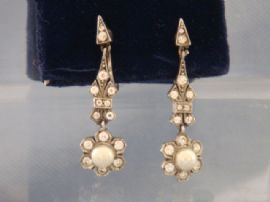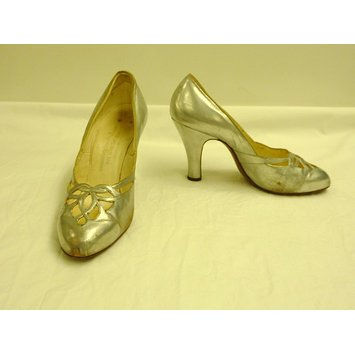Reno Sweeny dress analysis
- Jenna Deacon
- Jun 9, 2017
- 9 min read
First year is nearly over and our final dress history project was to write up a dress analysis on a chosen character. The lay outs not the same so allow me on this one as I couldn't embed the pictures into the text.
What would Reno Sweeny Wear?
In this essay I have chosen to study Reno Sweeney from Anything Goes, Reno is a fun loving showgirl and the female protagonist. Originally put on Broadway on 1934 with Patti LuPone as Reno it reopened in 1987 for a revival that lasted for 2 years. This is the version I have chosen to do as the script is easier to obtain and a photocopy is readily available online, the original script has not survived. The script any stage directions or notations regarding how Reno looks or dresses, nor do any characters comment on what she wears.
Key books and online resources:
Unknown, (2009), Encyclopedia of clothing and fashion
Ethan Mordden, (2013), Anything Goes: A History of American Musical Theatre
Debbie Sessions, (2010/2017), Vintage Dancer
Elyssa da Cruz,(2004) Met Museum
Key pictures and surviving artefacts:
Unknown, (2017), Berganza
V&A, (2017), V&A Collections
Unknown, (2017), Kays Catalogue
Archive, (2000) Gjenvick-Gjønvik Archives
Due to the lake of information about Reno I used these main sources to further my understanding of typical 1930s dress and how that translated the person’s personality. As Reno is such an avant-garde character I found it useful to learn the etiquette of 1930s dressing as I think she would break these conventions. As well as this I want to learn more about ocean cruisers and their impact on society as to further understand how life was very different on these boats.
Anything Goes is a lively lighthearted musical originally written in 1934 by Guy Bolton (23 November 1884 – 4 September 1979) and Pelham Grenville Wodehouse (15 October 1881 – 1975) the play is set on a cruise ship The S. S. America, sailing to England from New York in 1934. In a fame filled world, a boat full of socialites and a priest is not enough for the media hungry captain. When it turns out there is sought out criminal Moonface Martin on board the Passengers fall into excited hysterics. Amongst this, confused lovers fall into all the traps of love (and the also the traps Moonface has set) the text I am focusing on is the 1987 revival written by Timothy Crouse and John Weidman (Sep 25, 1946 New York). Weidman has a presence in Broadway and has written the books for many musicals and plays. He has also worked as a writer for award winning Sesame Street. I chose this version rather than the original based on availability and also this is the version used in most recent adaptations. Crouse himself stated
"The 1934 script was very funny, but not a lot of attention had been paid to what the characters were about, what they wanted, and what might constitute consistent behavior on their part," Weidman adds. "Our task was to take what was essentially a good story and craft it a little more so it would work for an audience in the 1980s."
The main characters are Reno Sweeney, Hope Harcourt, Evelyn Oakleigh, Billy Crocker and Moonface Martin, a mix of lower class and middle class. I'm focusing of the penultimate scene, scene 6 in Act One where Reno goes to seduce Evelyn, the bumbling fiancé of Hope Harcourt, a socialite who Billy is in love with. In hope Moonface can catch them in the act and frame Evelyn so Billy can have Harcourt all to himself. Little does Reno know, she will end up falling for Evelyn in this scene.
Character
Reno Sweeney is a seemingly simple character from the beginning, and is placed in the role of a woman scorned. Yet as the play continues we see a fragility played against her strength, mixed with a showbiz personality. Although she gives off this front, she is sensitive and alludes to a rough start in life. For example she believes that Billy led her on as he "Never laid a hand on me, and I'm not used to men treating me like that!" This insinuates that men in her past haven't treated her well, especially those who have claimed to love her. Furthermore this is backed up by her knowing Moonface "long time no see" (act 1 scene 5) one would not assume that a showgirl who claims faith would be mixing with this sort of crowd. Although no age is specified, we can assume she is young as she is successful currently as a showgirl and not married already. However not too young as she has her “Angels” who are her adoring backup singers. The average age of an actress to play this character is 20-35. She is quick witted which is evident through her interactions with the other characters as she can keep up with elaborate lies and plots effortlessly. I would say she is the relief in this play as although she has her own love dramas, she brings a large majority of the songs and exudes a love for almost everything.
Dress
The 1930s brought with it the great depression and the development of department stores, thus the market of cheaper ready to wear clothing was formed quickly and strongly. Reno herself is in the limelight so could be shopping at the higher end of the market, say designer wear. However I would doubt as a showgirl, mixed with her supposed rough upbringing, she would have purchased designer made to fit clothing. Also during this period European fashion started to seep into American culture, especially the French casual and relaxed look. Designers prevalent in 1934 are Chanel, Muriel King, Jean Patou, and Elsa Schiaparelli. These designers revolutionized women fashion as they brought a new silhouette and a new way of being a woman. Also as Reno is travelling to London it can be assumed she has connections in London, hence why I will also be looking at English designer. The scene is set at 4pm on a summer evening so one can assume that, regarding 1930's etiquette, Reno will be wearing a tea/afternoon dress, which was worn between a day dress and an evening dress. However as Moonface suggests to Reno to wear "something that can slip off easy" paired with the fact she is going to seduce Evelyn, she possibly could be wearing a cocktail dress, which were normally worn between 6pm-8pm. Tea dresses were typically made out of Rayon, silk, crepe and cotton. Bearing in mind Reno is going to seduce Evelyn I would say she would be wearing silk crepe or pure silk. It was common practice in 1930s to cut on the bias and make a statement with asymmetric block colours. The length of tea dresses is around mid-calf or just above, this is the perfect length for this time of year as it would be hot on the cruise ship. The main attraction on tea dresses is the sleeves, and this is arguably the component that shows the era the most. The aim of the sleeves was to make the wearer broader at the shoulder, this was achieved by gathering the sleeves at the shoulder and adding shoulder pads. Furthermore is common to see these dresses with lots of buttons down the front. However I would like to use a dress with a zip as this had the connotations of being too "vulgar" for women’s clothing as they were considered too fast at getting clothing off. Due to her reasons for being in Evelyn's room and her looser morals I feel this would be fitting. As Reno is on trend I would put her in a block colour dress, as to not take attention away from her beauty, with a bias cut skirt so that it would twirl dramatically during the scene, matching the atmosphere. As the theme of the play is nautical, I have chosen for the dress to be navy with white accents as these colours were used widely in these years. As can be seen in Fig 1, this 1934 summer collection by London based designer Elizabeth Handley-Seymour, This dress has the colour scheme I wanted and the draped neck has the drama I would expect of Reno. Also the sleeves and skirt has a decent amount of movement too them. Furthermore there are no visible buttons and the draped fabric gives the illusion it would be easier to take off as its not as fitted. Moreover the use of accessories, especially costume jewelry to complement these dresses was a way of showing ones wealth without being vulgar about it. For Reno I would use a small broach matched with large earrings as part of her costume as this would demonstrate to Evelyn that she is eligible for him, much like his wealthy fiancé Hope Harcourt. Earrings in the 1930s featured colored gems largely so to stand out against her navy dress I would use a pearl as this would still work with the nautical theme. Here these faux pear screw back earrings (fig2) are a perfect example of costume jewelry worn at the time. They are from Ciro, an English well know jewelers on Bond Street for their costume jewelry, and they are dated 1920-1930s however I believe they are more 1920s as the clip back earing was more prominent in 1930s. Although they are possibly older than 1934, due to the Depression it was common to buy secondhand. As with the jewelry, shoes did not change much in the early half of the decade compared the 20s before. The intricate cut outs and perforated holes on the shoes is what identifies them away from the rest. These 1930 leather silver shoes (fig3) were originally worn by the Queen Mother, so although out of Reno’s range. They illustrate well an evening shoe. Metallic silver, alongside gold and ivory were very popular colours and as Reno is flamboyant I think it right that she would mix it up and wear some snazzy shoes whilst trying to peacock herself. The fact that they are pumps and not the popular lace up oxfords or dancing sandals further implies her intentions with Evelyn regards to underwear, one can assume Reno would be wearing rather standard underwear on, as although she would want to be looking her best, if her intentions are followed through it would be impractical to have an overly restricting girdle. A mix of silk and merino was favoured for “pant briefs” as this was both comfortable and absorbent. The panties were cut on the bias and were loose, normally coming up over the stomach and down to mid-thigh-knee. The bra, after gaining momentum in the decade before started to become a staple for women, with the A-D cup sizing and adjustable hooks coming into play in 1932. Whilst this was a fast growing business it was still a common thing to make your own underwear, as seen in fig5 a Mccalls pattern from 1930s. It is entirely possible that Reno would make her own as I assume leading the life she does she needs a lot to work with all her revealing showgirl costumes. Furthermore as she is a showgirl she will probably have some sewing knowledge. She would also wear a girdle to create a soft and feminine shape. Here in fig4 taken from a kays catalogue from 1933 you can see the variations of Girdles available to order. With the discovery of latex, Lastex was used for many girdles.
In conclusion through this project I have learnt successfully the rules of dressing in 1934 and have developed my knowledge in further aspects of the fashion, such as shoes and jewelry. I also discovered more about my character as I had no information to go off, just her personality in her lines It improved my analytical skills and forced me to broaden my knowledge further into the cruise ship life and that as a show girl. With the garments I have chosen they suggest that she is a rule breaker and a special character as whilst the clothing is in line with the period shape, it is still somewhat out of place. The dress is more cocktail and she has dancing shoes on, illustrating that she is always showbiz. I think this will convey to the audience as the subtle differences will show against the other characters and the garments match her sparkly personality.




Bibliography
Angelasancartier.net. (2017). Girdle - Clothing and Fashion. [online] Available at: http://angelasancartier.net/girdle [Accessed 8 Jun. 2017].
AUTHOR. (2017). The Characters of Anything Goes. [online] Available at: https://auditionresource.wordpress.com/2012/06/15/the-characters-of-anything-goes/ [Accessed 8 Jun. 2017].
Berganza.com. (2017). Art Deco earrings of the 1920’s to 1930’s - A History of Earrings: Part 7. from Berganza London Hatton Garden. [online] Available at: http://www.berganza.com/history-of-earrings-art-deco-period-1920s-to-1930s.html [Accessed 8 Jun. 2017].
Bythedecade.blogspot.co.uk. (2017). Undressed: Women's Undergarments in the 1930s. [online] Available at: http://bythedecade.blogspot.co.uk/2016/02/undressed-womens-undergarments-in-1930s.html [Accessed 8 Jun. 2017].
Collections.vam.ac.uk. (2017). Your Search Results | Search the Collections | Victoria and Albert Museum. [online] Available at: http://collections.vam.ac.uk/search/?limit=15&narrow=1&q=1934&commit=Search&after-adbc=AD&before-adbc=AD&category%5B0%5D=THES49044&offset=45&slug=0 [Accessed 8 Jun. 2017].
Donshewey.com. (2017). Program notes by Don Shewey for Lincoln Center Theater's 1988 revival of"Anything Goes". [online] Available at: http://www.donshewey.com/theater_articles/anything_goes.html [Accessed 8 Jun. 2017].
Gjenvick, P. (2017). Passenger Lists - Social and Cultural History | GG Archives. [online] Gjenvick.com. Available at: http://www.gjenvick.com/#axzz4jRvqirk8 [Accessed 8 Jun. 2017].
Mordden, E. (2015). Anything goes. 1st ed. [Place of publication not identified]: Oxford University Press.
Pearson, T. and Pearson, T. (2017). Clothes and men's and ladies fashions in the 1930's prices and examples. [online] Thepeoplehistory.com. Available at: http://www.thepeoplehistory.com/30sclothes.html [Accessed 8 Jun. 2017].
Retrowaste.com. (2017). Fashion in the 1930s: Clothing Styles, Trends, Pictures & History. [on
Sondheimguide.com. (2017). Cole Porter / Anything Goes (1987 Revival). [online] Available at: http://www.sondheimguide.com/porter/anything87.html [Accessed 8 Jun. 2017].
Thomas, P. (2017). Undergarments History | Women's Pants, Drawers, Briefs and Knickers Fashion. [online] Fashion-era.com. Available at: http://www.fashion-era.com/drawers-pants-combinations-knickers-fashion.htm [Accessed 8 Jun. 2017].
VintageDancer.com. (2017). 1940s Lingerie- Bra, Girdle, Slips, Underwear History. [online] Available at: http://vintagedancer.com/1940s/1940s-lingerie-history/ [Accessed 8 Jun. 2017].
Vintagevisage.net. (2017). History of the Zipper. [online] Available at: http://www.vintagevisage.net/Zipper.html [Accessed 8 Jun. 2017].
Illustration List
Anon, (2017). [image] Available at: https://witness2fashion.wordpress.com/tag/womens-underwear-1930s/ [Accessed 8 Jun. 2017].
Anon, (2017). [image] Available at: HTTP://WWW.BAGTHEJEWELS.CO.UK/1920S---1930S-CIRO-PEARL-AND-DIAMANTE-SCREW-ON-EARRINGS-MARKED-SCP-SOLD-1864-P.ASP [Accessed 8 Jun. 2017].
Kays (2017). http://www.worldofkays.org/website/wp-content/uploads/archive-images/downloadable/KA33p422-downloadable.jpg. [image].
V&A (2017). Pair of Jack Jacobus shoes. [image] Available at: http://collections.vam.ac.uk/item/O350339/pair-of-shoes-jack-jacobus-ltd/ [Accessed 8 Jun. 2017].
V&A (2017). http://collections.vam.ac.uk/item/O571029/fashion-design-elizabeth-handley-seymour/. [image].











Comments